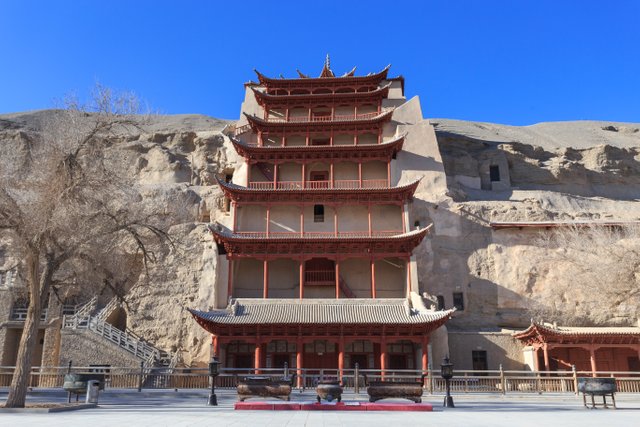Mogao Grottoes

It was built in the Sixteen Kingdoms period, according to Tang, "Rick let Mogao rebuilt shrines monument" records, Former Qin Jian-yuan two years (366 years), the monk's Le Zun passing the mountain, to find that golden shine, as now Wan Buddha, so he dug the first cave in the rock wall. Since then, Master Falling and others continued to build caves here to practice meditation, It is called "Mogao Grottoes", which means "high places in the desert". Later generations were renamed "Mogao Grottoes" due to the common use of "moor" and "Mo".[Source request] During the Northern Wei Dynasty, Western Wei DynastyandNorthern Zhou Dynasty, the ruler ChongxinBuddhismand the construction of the grottoes were supported by the princes and nobles, and developed rapidly. Sui and Tang dynasties, with the silk Roadprosperity, the Mogao Grottoes is flourishing inWuhas more than a thousand caves when. After the Anshi Rebellion, Dunhuang was occupied by theTuboandGuiyiArmysuccessively, but the statue activity was not greatly affected. The Mogao Grottoes during the Uighur period developed to the largest peak in history. The famous or clear and complete portraits and Buddhist carvings are seen so far are basically restored and newly built during this period. Northern Song Dynasty, Western XiaandYuanon behalf of, the Mogao Grottoes gradually fading, only to rebuild the former Kushi-based, the new minimal. After the Yuan Dynasty, with the abandonment of the Silk Road, the construction of Mogao Grottoes also stopped and gradually disappeared into the world's vision. It wasn't until the forty years (1701) of Kangxi in the theming Dynastythat people paid attention to it again. In modern times, people often call it "Thousand Buddha Cave".
There are 735 caves from the Northern Wei Dynasty to the Yuan Dynasty in Mogao Grottoes, which are divided into north and south areas. The Southern District is the main body of the Mogao Grottoes, a place for monks to engage in religious activities. There are 487 caves with murals or statues. There are 248 caves in the North District, only 5 of which have murals or statues, and the others are places where monks practice, live and bury after death, and there are living facilities such as earthen kangas, stovetops, flues, niches, desk lamps, and other living places. There are a total of 492 caves in the two districts with murals and statues, including 45,000 square meters of murals, 2,415 clay-colored sculptures, 5 wooden eaves in the Tang and Song Dynasties, thousands of lotus pillars, and floor tiles.